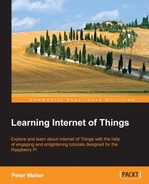One of the major problems we encountered when we looked at the HTTP, UPnP, and CoAP protocols is how to cross firewall boundaries. Firewalls not only block incoming connection attempts, but they also hide a home or office network behind a single IP address. Unless the firewall blocks outgoing connections, which it does only if explicitly configured to do so, we can cross firewall boundaries if all the endpoints in a conversation act as clients to a common message broker that lies outside of the firewall and is therefore accessible to everybody. The message broker acts as a server, but all it does is relay messages between clients. One protocol that uses message brokers is the Message Queue Telemetry Transport (MQTT) protocol.

In this chapter, you will learn the following concepts:
- The basic operations available in MQTT
- How to publish data using MQTT topics
- How to subscribe to MQTT topics
- How to implement MQTT in the sensor, actuator, and controller
The MQTT protocol is based on the publish/subscribe pattern, as opposed to the request/response and the event subscription patterns studied in the previous chapters. The publish/subscribe pattern has three types of actors:
Content is identified by topic. When publishing content, the publisher can choose whether the content should be retained by the server or not. If retained, each subscriber will receive the latest published value directly when subscribing. Furthermore, topics are ordered into a tree structure of topics, much like a filesystem. The forward slash character (/) is used as a delimiter when describing a topic path. When subscribing to content, a subscriber can subscribe to either a specific topic by providing its path, or an entire branch using the hash wildcard character (#). There's also a single-level wildcard character: the plus character (+). As an example, to illustrate topic semantics, our sensor will publish measured temperature on the Clayster/LearningIoT/Sensor/Temperature topic. Subscribing to Clayster/+/Sensor/# will subscribe to all the subbranches of the Sensor class that start with Clayster/, then any subtopic, which in turn will have a Sensor/ subtopic.
The architecture of MQTT is shown in the following diagram:

There are three Quality of Service levels in MQTT available while publishing content. The lowest level is an unacknowledged service. Here, the message is delivered at most once to each subscriber. The next level is an acknowledged service. Here, each recipient acknowledges the receipt of the published information. If no receipt is received, the information can be sent again. This makes sure the information is delivered at least once. The highest level is called the assured service. Here, information is not only acknowledged but sent in two steps. First it is transmitted and then delivered. Each step is acknowledged. This makes it possible to make sure that the content is delivered exactly once to each subscriber.
Tip
The support for user authentication in MQTT is weak. Plain text username and password authentication exists, but it provides an obvious risk if the server is not hosted in a controlled environment. To circumvent the most obvious problems, MQTT can be used over an encrypted connection using SSL/TLS. In this case, it is important for clients to validate server certificates else user credentials may be compromised.
Other methods, not defined in the MQTT protocol itself, include the use of client-side certificates or preshared keys to identify clients, instead of using the username and password option provided by the protocol. Proprietary methods of encrypting the contents can also be used to make sure only receivers with sufficient credentials can decrypt the contents. Even though this method works, it reduces interoperability and provides an additional load on each device, which is contrary to the stated goal of the protocol.
As the MQTT protocol itself does not consider security, it is very important for developers to consider security themselves. Furthermore, user credentials must be managed manually or by using proprietary out-of-band methods.
